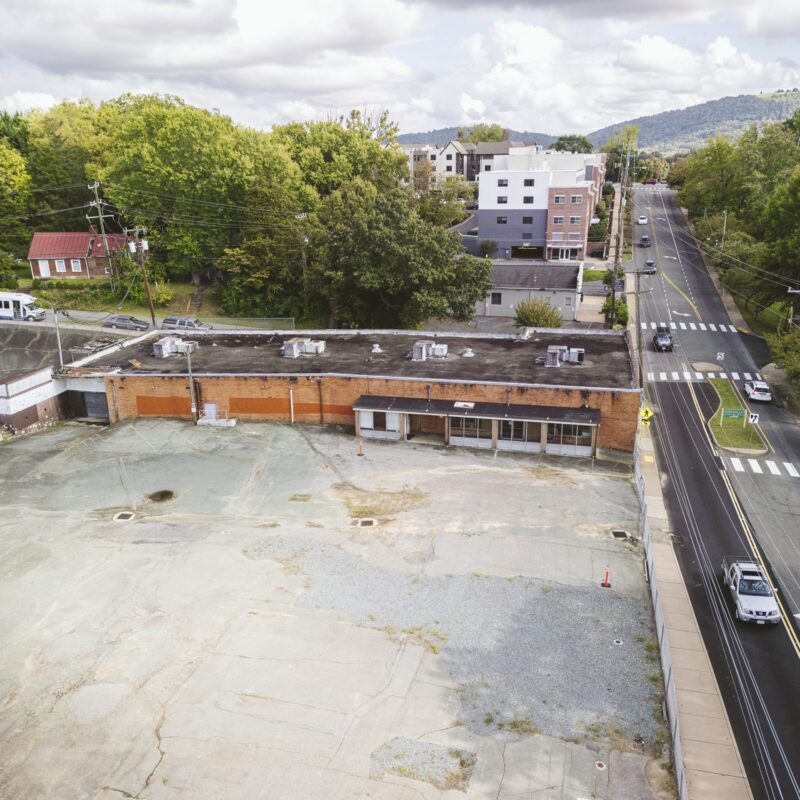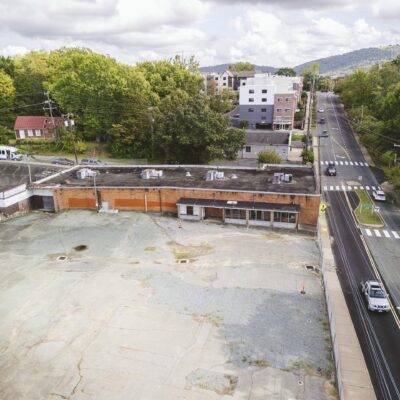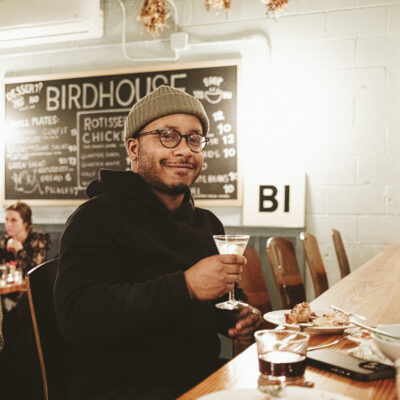 On a map of Charlottesville, West Main Street lies smack in the middle of the city. For almost two centuries, this central location has attracted commerce, and it flourished in two waves. A third wave is currently rising in hotels and dining, or what is called the hospitality industry. A local business association has even dubbed the area “Midtown,” hoping to grab some of the glamor of New York. Whether that name will stick remains to be seen, but redevelopment is clearly visible on the ground.
On a map of Charlottesville, West Main Street lies smack in the middle of the city. For almost two centuries, this central location has attracted commerce, and it flourished in two waves. A third wave is currently rising in hotels and dining, or what is called the hospitality industry. A local business association has even dubbed the area “Midtown,” hoping to grab some of the glamor of New York. Whether that name will stick remains to be seen, but redevelopment is clearly visible on the ground.
West Main Street follows the colonial-era route called Three-Notched Road, which was laid out between Richmond and Rockfish Gap in 1733. In part, this route follows much older Native American trails. Running generally east-west, the Three-Notched Road became the Main Street of the new city of Charlottesville in 1762. About a mile to the west, in 1825 it became the northern boundary of the University of Virginia. These two historic poles, now generally known as Downtown and The Lawn, have shaped urban development ever since.
At least two comprehensive studies have been done of West Main Street. In July 1977, some University of Virginia faculty published “West Main Street: Present Conditions and Future Prospects,” for the League of Cities—Conference of Mayors. Conditions at the time were poor, as in many American cities, with high vacancy, neglect and racial tension. The “future prospects” included new multifamily housing and office space to fill what were seen as gaps in the urban fabric. In January 1993, city officials produced the “West Main Street Task Force Report,” mainly in response to the university’s idea of building a new residential college, modeled on those of Oxford, Cambridge, Harvard and Yale. The proposed college never materialized, though UVA has crept into the area.
Like many preindustrial roads, West Main Street lies on a ridge. This fact of topography is evident as you move along the street, and the land falls away to either side. The slopes are a challenge to development, while the long, straight stretch is too narrow for a planted boulevard. Still it could be a processional way as well as a traffic route. Republic Plaza at 855 West Main Street, with its sidewalk arcade and imposing brick mass, shows the possibilities.
Equally important are the man-made features of two railroad lines. In 1845, the Chesapeake & Ohio (now CSX) came to town from Richmond. It parallels the street, leaving a narrow strip of land on the south for buildings. The Norfolk & Southern line, opened in 1863, intersects midway, and giving to a depot now known as the Amtrak Station. Adding to the transportation nexus, the Trailways bus station relocated in 1963 on West Main Street.
From the 1870s on, West Main Street became a center for hotels, restaurants, apartments, and related businesses, displacing many houses. One survivor from this era is the Albemarle Hotel of 1890, at 617 West Main Street, long famous for its dining room. It is now converted to offices, with shops at street level behind a cast-iron colonnade. Significant survivors from the residential past are two small groups of brick rowhouses, both adapted for other uses: the Vowles Houses of 1824-1839, now the University of Virginia Medical Alumni office, and the Livers Houses of 1825-1835, now the Dinsmore bed and breakfast. The splendid red brick Patton House of 1845, with its white Doric porch and frieze, is now a branch of the University of Virginia Community Credit Union.
In the early twentieth century, West Main Street embraced the automobile. Car showrooms, tire dealers, automotive repair shops and related businesses all located here, up to 24 of them by 1950. Most have since migrated to the edges of town, but two remain: Team Tires and University Tire & Auto. Buildings that once served the car trade also remain, adapted to other uses. The most striking of these is Main Street Market, a collection of specialty food, wine and kitchenware shops, with places to eat and drink. Next door, the Zinc Bistro occupies a former gas station, with roll-up doors at the service bays.
Another former car dealer and repair shop in the 500 block is listed for sale. This industrial-looking complex briefly housed John Sarah John, an avant-garde art studio, gallery, espresso bar, and event space. Just to the east, a similar no-frills structure houses start-ups like Random Row Books. Arguably the counterculture epicenter of Charlottesville, Random Row has new and used books; a cavernous space for music, films and readings; artist studios; a community bulletin board; and a stream of visiting performers and social activists. If you want to know what’s happening off the grid, go to their blog, get on their email list, and drop in to chat.
At the opposite end, Kane Furniture is a tenacious survivor from a time when West Main had neighborhood shops, a Safeway grocery store, and a Sears Roebuck store. With a parking garage for the UVA Hospital looming behind, the new Courtyard Marriott Hotel across the street, and chain retailers lurking on the outskirts, Kane Furniture represents the locally owned and managed businesses that sustain a city.
While it was and is a commercial spine, West Main Street is also the geographic center of Charlottesville’s African-American residents, who settled in neighborhoods north and south of the street. In the years after the Civil War and emancipation, they founded no fewer than three churches here. All three are significant red brick structures. Two are still in active use: First Baptist Church in the middle, with its white domed steeple; and Ebenezer Baptist Church of 1908, set back on 6th Street. The Mount Zion First African Baptist Church of 1878, just around the end of West Main at 105 Ridge Street, has been adapted for use as the Music Resource Center, for musical practice and recording.

Speaking of architecture, the Amtrak Station deserves mention. Set in an open space of tracks, newly paved parking and trees, the brick station of 1885 and a picturesque baggage depot of 1915 were renovated in 1999. The old station became a restaurant called Wild Wing Cafe, and the baggage depot became the new waiting room. Passenger traffic increased, and the space is now inadequate: the station is busy with three daily trains and new commuter service to Washington, DC.
West Main Street is still partly residential. It runs through two neighborhoods as defined by the city, tiny Starr Hill and the larger area called 10th and Page. Starr Hill has a clutch of narrow streets and small houses, a charming area that has seen “gentrification” in the past few years, with a shift from rental to owner-occupied housing. Given the central location and the demand for city living, some change seems inevitable.
The 10th and Page neighborhood has seen construction of new houses, a cluster of ten or more at the namesake intersection. A few steps away is the public housing complex called Westhaven. Built in 1965, the first of Charlottesville’s public housing sites with 126 townhouse units, Westhaven has had its share of controversy. Located just one block north of West Main Street, it seems isolated due to the steep slope and the site plan, based on the private loop of Hardy Street. A poor record of maintenance did not help. Recently, the city proposed to replace all its public housing and effectively wipe out Westhaven. Funding for such an ambitious plan is not available, but a pedestrian route to West Main would be an affordable improvement.
Proof that a residential enclave can be functional and attractive comes just to the south, in the new condominium development called Walker Square. Built in 2005, the complex includes upscale features like a clubhouse, swimming pool and fitness center. Visible from West Main across the train station parking lot and tracks, Walker Square relies on location and site plan for its appeal, rather than design. Currently a mix of rental and owner-occupied units, it is convenient to the UVA Hospital, to other employment and bus lines, and to the restaurants that line West Main Street.
History has repeated itself in that West Main is again a dining destination. An arbitrary sample includes the newly opened Balkan Bistro, the venerable Blue Moon Diner and Mel’s Cafe, outdoor seating at Maya and Horse & Hound, the traditional West Main Restaurant, and the chic L’Etoile, overlooking the railroad on Starr Hill.
Specialty food shops have also sprung up, starting with the wine, cheese, bakery, chocolate, and fish shops in Main Street Market. For sheer wonder, check out Grand Market across the street at 323 West Main, with foods imported from Greece, Turkey, the Middle East, India, and farther afield. For convenience, a Virginia ABC liquor store is here, too.
At a time when new development is scarce, this area has two major construction projects under way, with a third poised to start. At the west end, the UVA Hospital is adding to its complex with the Battle Building, for children and outpatient surgery. At the east end of the neighborhood, at the corner of Preston Avenue and 4th Street, 60 apartments are going up for single room occupancy, or SRO, by Virginia Supportive Housing.
Also to the east, the Jefferson School property has been in the news for putting together a financial package that will allow extensive renovation for office and community use. In the days of racially segregated public schools, the Jefferson School educated black students. A huge, rambling brick structure, with significant open space and a central location, it then stood empty for many years. When construction goes ahead, it will not only preserve a cultural landmark, but connect Downtown to West Main and add to commercial life.
Life was very much in evidence on Saturday afternoon, September 10, during the second annual Midtown Street Fair. A section from 4th to 7th Streets was closed to traffic, and a variety of booths, tables, walkers, bicycles, pedicabs, and lady arm wrestlers took over the pavement. Three performance stages were set up, with a schedule of karaoke and professional music. The Midtown Business Association says: “Our goal is for this event to become an integral experience in the Charlottesville social landscape.” The center of the action was a barbecue cookoff, but there was plenty of other street food, mixed with children’s face-painting, artisan crafts, a photo booth, and displays for local magazines.
There is a free shuttle bus between the University and Downtown, and foot traffic, including joggers and tourists, increases year after year. As the Charlottesville area continues to grow and develop, West Main Street will likely maintain its place at the center, with a style that is urban, gritty, progressive, and multicultural. The New South that emerged in cities like Richmond and Atlanta may finally gain a foothold here.
 On a map of Charlottesville, West Main Street lies smack in the middle of the city. For almost two centuries, this central location has attracted commerce, and it flourished in two waves. A third wave is currently rising in hotels and dining, or what is called the hospitality industry. A local business association has even dubbed the area “Midtown,” hoping to grab some of the glamor of New York. Whether that name will stick remains to be seen, but redevelopment is clearly visible on the ground.
On a map of Charlottesville, West Main Street lies smack in the middle of the city. For almost two centuries, this central location has attracted commerce, and it flourished in two waves. A third wave is currently rising in hotels and dining, or what is called the hospitality industry. A local business association has even dubbed the area “Midtown,” hoping to grab some of the glamor of New York. Whether that name will stick remains to be seen, but redevelopment is clearly visible on the ground. Speaking of architecture, the Amtrak Station deserves mention. Set in an open space of tracks, newly paved parking and trees, the brick station of 1885 and a picturesque baggage depot of 1915 were renovated in 1999. The old station became a restaurant called Wild Wing Cafe, and the baggage depot became the new waiting room. Passenger traffic increased, and the space is now inadequate: the station is busy with three daily trains and new commuter service to Washington, DC.
Speaking of architecture, the Amtrak Station deserves mention. Set in an open space of tracks, newly paved parking and trees, the brick station of 1885 and a picturesque baggage depot of 1915 were renovated in 1999. The old station became a restaurant called Wild Wing Cafe, and the baggage depot became the new waiting room. Passenger traffic increased, and the space is now inadequate: the station is busy with three daily trains and new commuter service to Washington, DC. 


